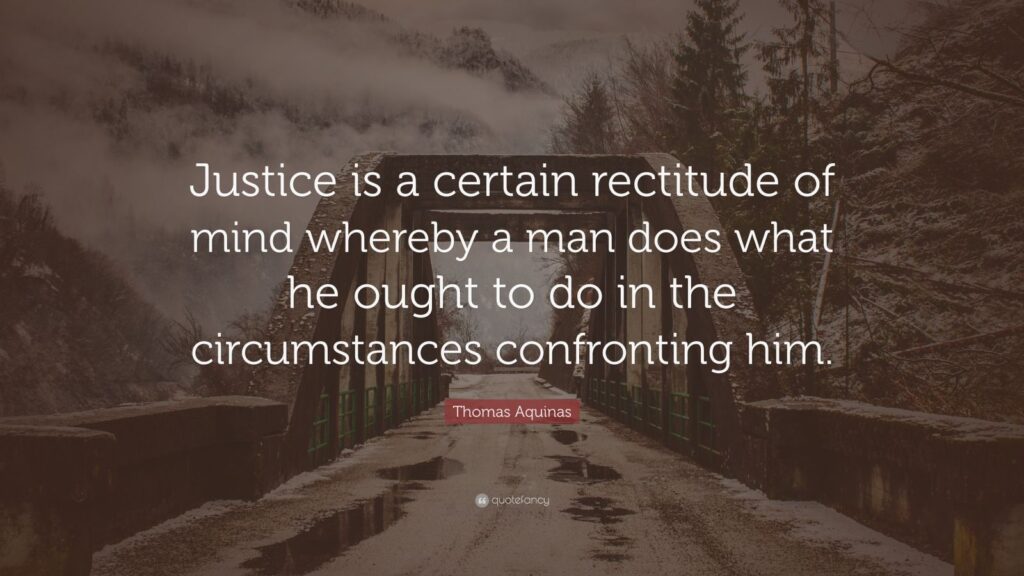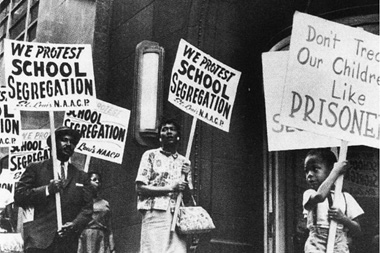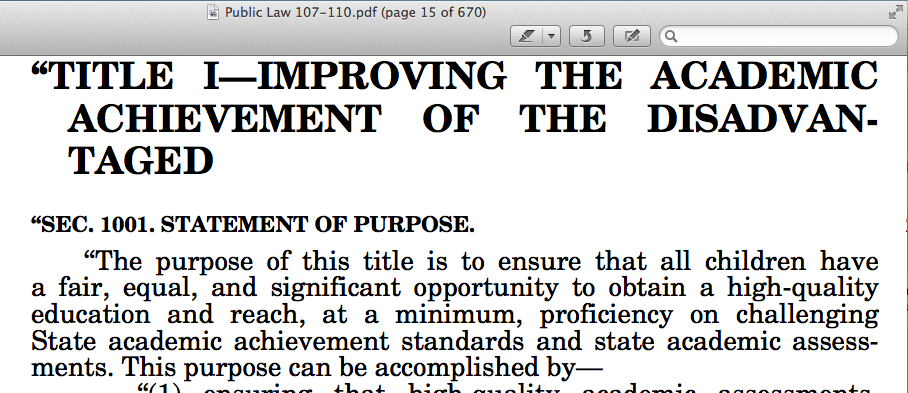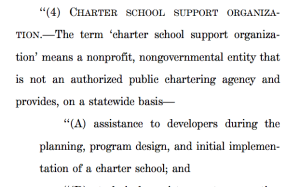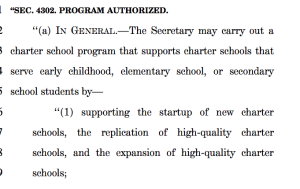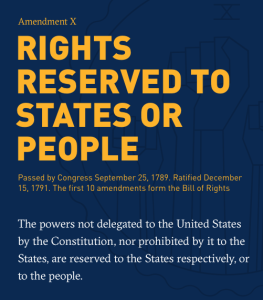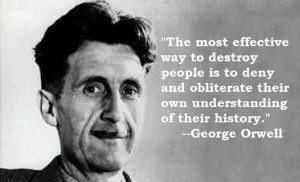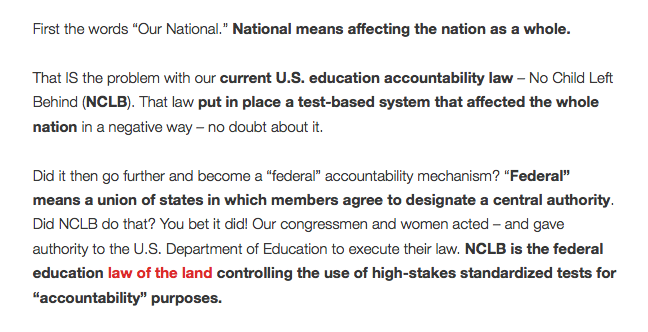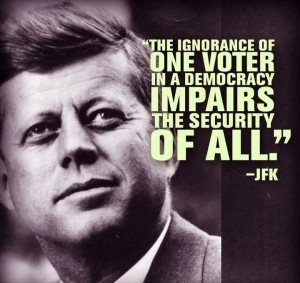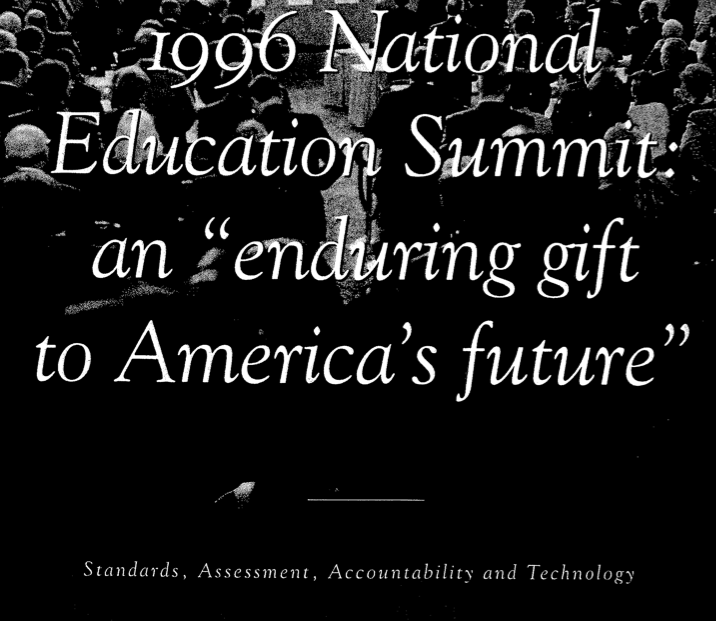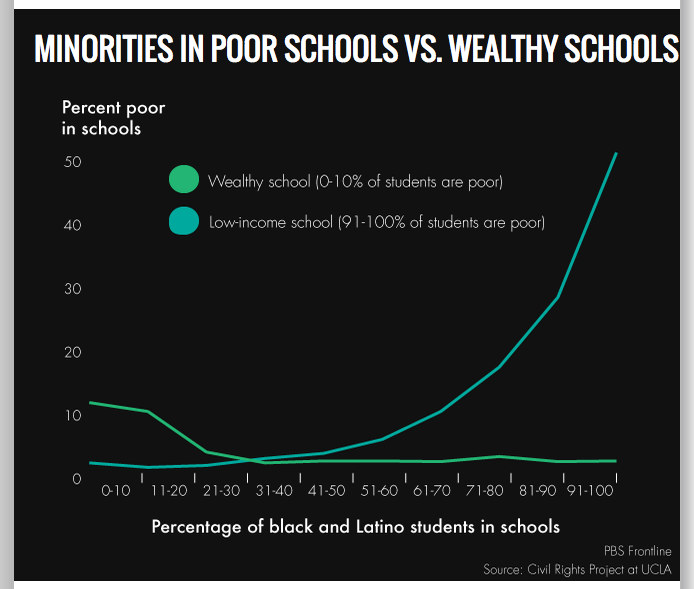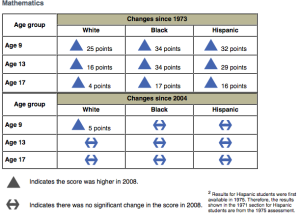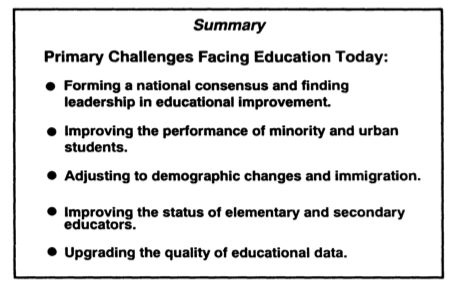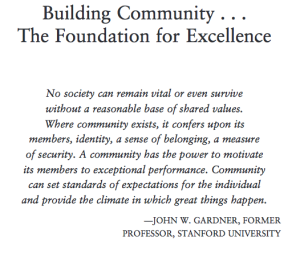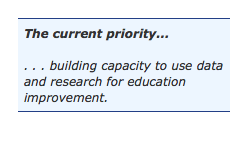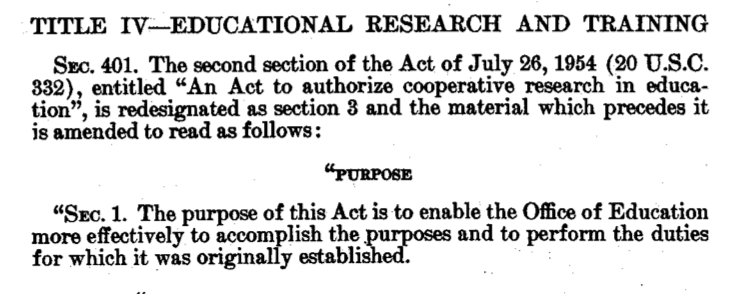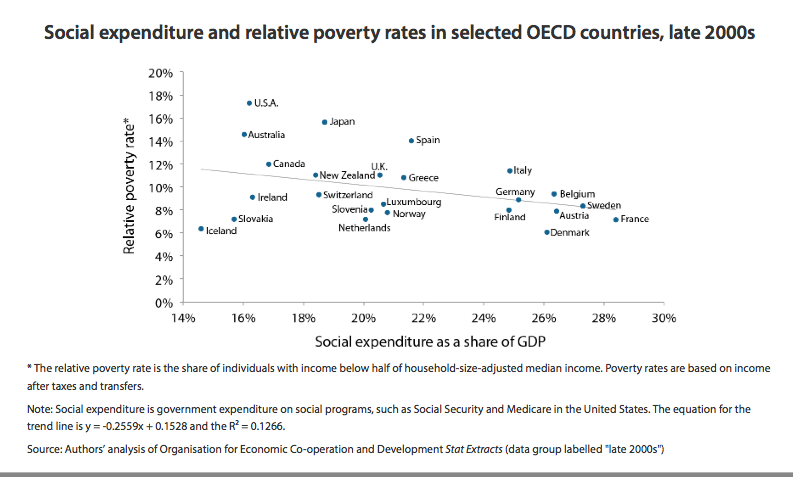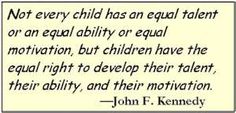In the mid-1800’s, an Italian Jesuit gave rise to the phrase “social justice.” But today, its use as a political wedge leaves its meaning unclear to many. It’s meaning is based on Italian theologian “Thomas Aquinas’ idea that, in addition to doing the right thing, we should strive to do what is necessary for the betterment of others.” Five Principles of Social Justice, Kent State.
Social Justice: Born from Revolution
When economic inequality produced economic distress, the resultant turmoil of the French Revolution birthed the social justice concept. Over time, its meaning began to vary based on “political orientation, religious background, and political and social philosophy.” Therefore, speaking in general terms, social justice is the concept “that people have equal rights and opportunities; everyone … deserves an even playing field.” Tricia Christensen
America’s Declaration of Independence proclaimed that “all men are created equal.” But that declaration is merely the foundation for the promise of America.
“… the Declaration of Independence … was a call for the right to statehood rather than individual liberties, says Stanford historian Jack Rakove. Only after the American Revolution did people interpret it as a promise for individual equality.” Stanford News
Thus, America’s journey towards equality of individual rights and opportunities is guided by the U.S. Constitution. But we haven’t reached our constitutional obligation to “promote the general Welfare.” Regrettably, our roadblock is in determining what opportunities to provide equally. So consider this:
“By and large, it is for Congress to determine what constitutes the “general welfare.”
“… Congress may enact legislation ‘necessary and proper” to effectuate its purposes in taxing and spending.” Spending for the General Welfare: Scope of the Power
Linking Social Justice, the Civil Rights Movement, and Critical Race Theory
Social justice is America’s target while civil rights’ work is to protect all citizen’s rights — in theory. But social justices’ progress apparently requires constant strife —examples being the Civil War and Civil Rights Movement. Currently, progress faces new roadblocks.
The Civil Rights Movement spawned new laws — Fair Housing Act, Voting Rights Act, the 1964 Civil Rights Act, and 1965 Elementary and Secondary Education Act — all to protect citizens against discrimination. But over time, changes to enforcement and the laws have us backsliding. Awareness of that reversion is what brought Critical Race Theory (CRT) into existence.
What is the Theory?
CRT is an academic response to Critical Legal Studies —which sees “the law as necessarily intertwined with social issues …” emphasizing socioeconomic factors. But other scholars saw race as playing a more critical role than socioeconomic identity. Those scholars focused critically on the factors underlying racial inequality.
Here is a summary based on Dennis Fabrizi’s explanation of the three core themes of the theory.
- The theory sees racism infused in the everyday fabric of society.
- CRT raises the concept of ‘interest convergence’, a notion that white people have little incentive to eliminate racism except when the idea of greater equality operates in their own interests.
- It emphasizes ‘storytelling’ as a way to advance understanding of what it is like to be racially “minoritised”.
Why Is this Background Information Important?
By mid-September of 2020, the country fell prey to misinformation and disinformation! We all saw it happen but didn’t know enough to stop it.
“Perhaps the most controversial proposition of critical race theory is the idea that racism is built into American law and everyday life.” …
“Ironically, Trump’s most recent executive order banning racial sensitivity training confirms critical race theory’s central point: Racism is embedded in the law.” Victor Ray, Professor of Sociology, University of Iowa
 The former president’s executive order halting all federal employee’s “diversity training” was a temporary setback. But it’s trickle-down effect is disastrous. By declaring the theory to be “un-American propaganda,” the political strategy of de-funding public education spread from K-12 up to higher education and down to pre-K.
The former president’s executive order halting all federal employee’s “diversity training” was a temporary setback. But it’s trickle-down effect is disastrous. By declaring the theory to be “un-American propaganda,” the political strategy of de-funding public education spread from K-12 up to higher education and down to pre-K.
“We’re indoctrinating our children at a younger level here. … the curriculum’s is already written, there’s social justice in it” said Rep. Heather Scott, R-Blanchard [Idaho]. And [organizations] indoctrinate children with its own beliefs regarding “anti-bias education.” …. Idaho House rejects pre-K federal grant

This Big Bucks-funded “non-profit”, Turning Point USA, is a piece of the propaganda network set up to undermine the institutions of public education.
Misinformation Turns Into Bad Policies
Through networks of media sources, intentional messaging linked critical race theory to “dismantling all social norms” to “replacement of all systems of power” to being so “dangerous” it warrants laws to restrict its subject matter in schools! Let’s be clear. The messages make everyday words—like diversity and inclusion—sound like something we don’t welcome in America!
Messages heard; misinformation consumed. The result? Many state legislatures fell in lock-step to control the curriculum content in schools and de-fund those that don’t comply.

This Facebook post is from Idaho House Representative Tammy Nichols. Her rampage to de-fund Boise State University went public in September, 2019 and continues to the present.
“What’s happening in Idaho is not unique. All over the country, state legislators are trying to curtail teaching about racism and sexism, in universities as well as elementary schools.” Michelle Goldberg
We Have to Stop the Destruction of Our Language
If public institutions can provide opportunities for ALL citizens to participate in American life, liberty and the pursuit of happiness, then our policies must focus on what is “necessary and proper” to achieving that goal. But to do so, we must first stop the corruption of our political language. Equal, equality, equity, racism, sexism, privilege, diversity, “identity politics” — all of these words and more have been vilified and used to divide us.
If critical race theory helps explain why social justice is no closer to becoming a reality in America than it was in the 60’s, then let’s hear it. But if there are individual professors, teachers, or trainers misrepresenting or misusing the theory, by all means, stop those individuals. Do it without undermining public education and halting progress towards the promise of America.
The Dangers?
There is a real danger in forgetting the self-evident truism upon which America assumed independence— “all men are created equal”. Those written words only launched America’s journey towards building a nation capable of providing opportunities for all to live free, as equals. Social justice is the means to that end.
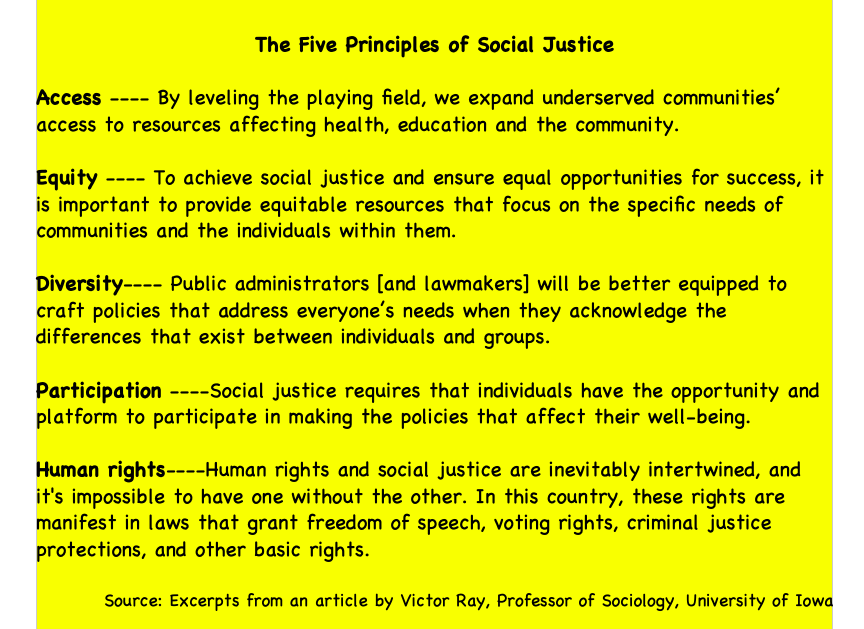 The danger is the fear created by those wishing to keep us divided. But it’s misinformation and misunderstandings producing the fear. Most Americans rightfully want acceptance without prejudice waged upon them due to their looks, speech, or individual choices.
The danger is the fear created by those wishing to keep us divided. But it’s misinformation and misunderstandings producing the fear. Most Americans rightfully want acceptance without prejudice waged upon them due to their looks, speech, or individual choices.
The biggest danger is in vilifying the very meaning and goals of social justice.
A false narrative is circulating that social justice, critical race theory, and anti-bias education creates division. The propaganda claims that social justice advocates set a goal of giving everyone the same (equal) outcomes in life. In reality, we know that human differences (motivations, talents, etc.) play a role in “the outcome” of our lives. Life has never been a pie where we all get an identical slice.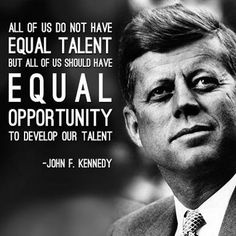
The Expectations
In America, we expect fairness. We expect to not face discrimination when it comes to housing, voting, employment, and public education opportunities.
“Equality, in the American sense of the word, is not an end but a beginning. It means that, so far as the state can do it, all children shall start in the race of life on an even line. The chief agency for this purpose is the public school system.”
— Edwin E. Slosson, 1921
So yes, anti-bias education —of our young— has a role to play in providing equal rights and opportunities. But without understanding the intended meanings of words used by any anti-bias author or speaker, we risk falling prey to “altered meanings.” Expect clarification.
Is anti-bias education indoctrination into a political ideology? Or is it the concept of “love your neighbor as yourself”?
“The heart of anti-bias work is a vision of a world in which all children are able to blossom, and each child’s particular abilities and gifts are able to flourish.” Anti-Bias Education for Young Children and Ourselves
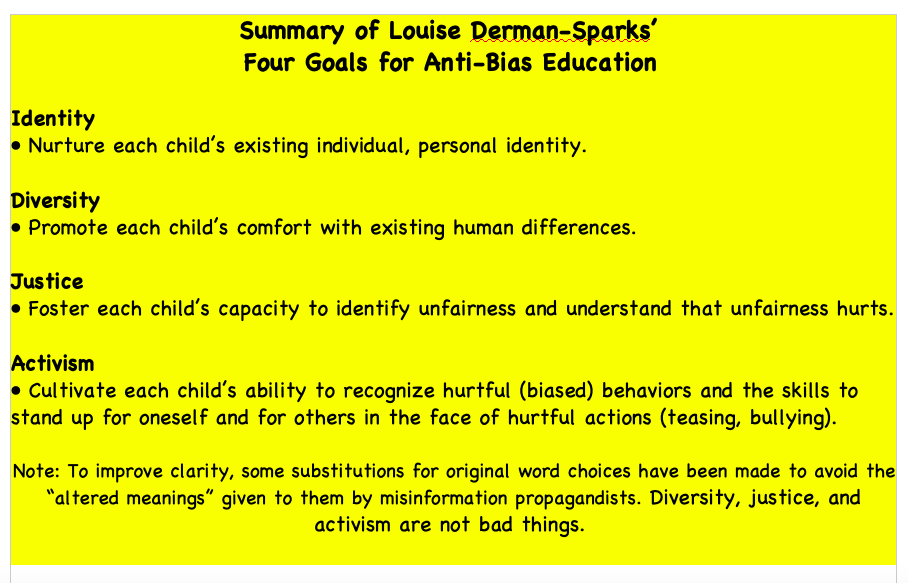 Did I mention participation, diversity of ideas and opinions, and inclusion of minority views make for a policy process MORE LIKELY to represent the People of the United States? Expect the policy-making process to work as intended.
Did I mention participation, diversity of ideas and opinions, and inclusion of minority views make for a policy process MORE LIKELY to represent the People of the United States? Expect the policy-making process to work as intended.
“[T]he laying of taxes is the power, and the general welfare the purpose for which the power is to be exercised.” — Thomas Jefferson
Congress decides our national Welfare.

